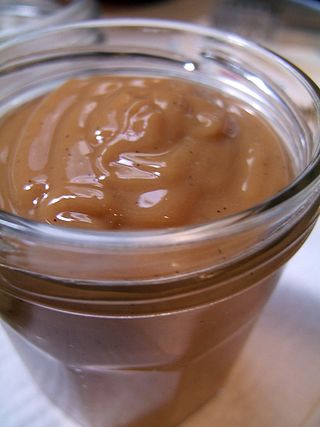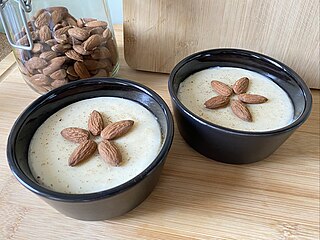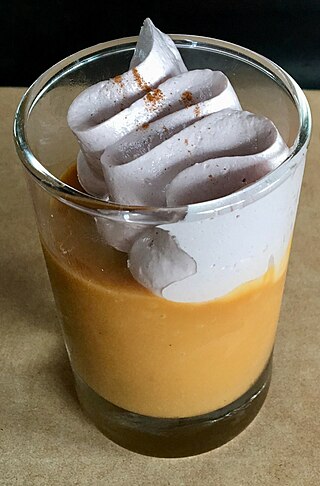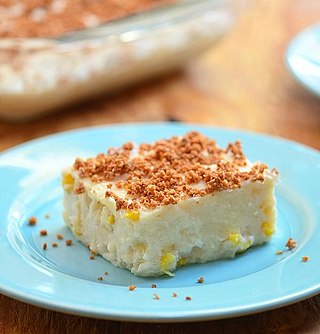
Blancmange is a sweet dessert popular throughout Europe commonly made with milk or cream and sugar thickened with rice flour, gelatin, corn starch, or Irish moss, and often flavoured with almonds.

Brazilian cuisine is the set of cooking practices and traditions of Brazil, and is characterized by European, Amerindian, African, and Asian influences. It varies greatly by region, reflecting the country's mix of native and immigrant populations, and its continental size as well. This has created a national cuisine marked by the preservation of regional differences.

Pudding is a type of food. It can be either a dessert, served after the main meal, or a savoury dish, served as part of the main meal.

Puerto Rican cuisine consists of the cooking style and traditional dishes original to Puerto Rico. It has been primarily influenced by the ancestors of the Puerto Rican people: the indigenous Taínos, Spanish colonizers, and sub-Saharan African slaves. As a territory of the United States, the culinary scene of Puerto Rico has also been moderately influenced by American cuisine.

Dulce de leche, caramelized milk, manjar, milk candy or milk jam is a confection popular in Latin America, France, Poland and the Philippines prepared by slowly heating sugar and milk over a period of several hours. The resulting substance, which takes on a spreadable, sauce-like consistency, derives its rich flavour and colour from non-enzymatic browning. It is typically used to top or fill other sweet foods.

Haupia is the Hawaiian name for a traditional coconut pudding found throughout Polynesia.

The manjar blanco, known in Catalan as menjar blanc or menjablanc, is a term used in Spanish- and Catalan- speaking areas of the world in reference to a variety of milk-based delicacies. It refers to variations of blancmange, a European delicacy found in various parts of the continent as well as the United Kingdom.

Tavukgöğsü is a Turkish milk pudding made with shredded chicken breast. It was a delicacy served to Ottoman sultans in the Topkapı Palace, and is now a well-known dish in Turkey.

Natillas is a term in Spanish for a variety of custards and similar sweet desserts in the Spanish-speaking world. In Spain, this term refers to a custard dish made with milk and eggs, similar to other European creams as crème anglaise. In Colombia, the delicacy does not include eggs, and is called natilla.

Suspiro de limeña or Suspiro a la limeña is a dessert of Peruvian gastronomy.
Coconut pudding may refer to

Tembleque is a coconut dessert pudding from Puerto Rico similar to blancmange and related to Latin American manjar blancos and Filipino maja blanca. It is one of the most popular desserts in Puerto Rican cuisine.

Maja blanca is a Filipino dessert with a gelatin-like consistency made primarily from coconut milk. Also known as coconut pudding, it is usually served during fiestas and during the holidays, especially Christmas.

Coconut bar is a refrigerated dim sum dessert found in Hong Kong, Taiwan, Southern China and in overseas Chinatowns. It is sweet and has a soft, gelatin-like texture but is white in color rather than translucent like gelatin. It is sometimes referred to as coconut pudding.

Ají de gallina is a Peruvian chicken stew. The dish is considered a popular Peruvian comfort food, and the name translates to "chicken chili" or "hen's chili" in English. Ají de gallina is composed of a sofrito base made by sautéing red onion, garlic, and ají amarillo together, and adding shredded poached poultry and stock. The stew is then thickened with bread soaked in milk or evaporated milk, cheese such as parmesan, and ground nuts such as pecans or walnuts. Ají amarillo is a mildly spicy pepper native to South America, common in many Peruvian cuisine dishes. Ají de gallina is typically served with boiled potatoes and white rice, and garnished with black olives and hard-boiled egg.













